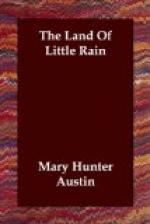Whatever goes up or comes down the streets of the mountains, water has the right of way; it takes the lowest ground and the shortest passage. Where the rifts are narrow, and some of the Sierra canons are not a stone’s throw from wall to wall, the best trail for foot or horse winds considerably above the watercourses; but in a country of cone-bearers there is usually a good strip of swardy sod along the canon floor. Pine woods, the short-leafed Balfour and Murryana of the high Sierras, are sombre, rooted in the litter of a thousand years, hushed, and corrective to the spirit. The trail passes insensibly into them from the black pines and a thin belt of firs. You look back as you rise, and strain for glimpses of the tawny valley, blue glints of the Bitter Lake, and tender cloud films on the farther ranges. For such pictures the pine branches make a noble frame. Presently they close in wholly; they draw mysteriously near, covering your tracks, giving up the trail indifferently, or with a secret grudge. You get a kind of impatience with their locked ranks, until you come out lastly on some high, windy dome and see what they are about. They troop thickly up the open ways, river banks, and brook borders; up open swales of dribbling springs; swarm over old moraines; circle the peaty swamps and part and meet about clean still lakes; scale the stony gullies; tormented, bowed, persisting to the door of the storm chambers, tall priests to pray for rain. The spring winds lift clouds of pollen dust, finer than frankincense, and trail it out over high altars, staining the snow. No doubt they understand this work better than we; in fact they know no other. “Come,” say the churches of the valleys, after a season of dry years, “let us pray for rain.” They would do better to plant more trees.




